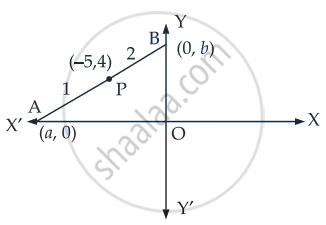Advertisements
Advertisements
प्रश्न
If the intercept of a line between the coordinate axes is divided by the point (–5, 4) in the ratio 1 : 2, then find the equation of the line.
उत्तर
Let a and b be the intercepts on the given line.
∴ Coordinates of A and B are (a, 0) and (0, b) respectively
∴ – 5 = `(1 xx 0 + 2 xx a)/(1 + 2)`
⇒ 2a = – 15 .......`[(because "X" = (m_1x_2 + m_2x_1)/(m_1 + m_2)),("and" "Y" = (m_1y_2 + m_2y_1)/(m_1 + m_2))]`
⇒ a = ` (-15)/2`
∴ A = `((-15)/2, 0)`
And 4 = `(1 xx b + 0 xx 2)/(1 + 2)`
⇒ 4 = `b/3`
⇒ b = 12
∴ B = (0, 12)

So, the equation of line AB is
y – y1 = `(y_2 - y_1)/(x_2 - x_1) (x - x_1)`
y – 0 = `((12 - 0)/(0 + 15/2)) (x + 15/2)`
⇒ y = `(12 xx 2)/15 (x + 15/2)`
⇒ y = `8/5(x + 15/2)`
⇒ 5y = 8x + 60
⇒ 8x – 5y + 60 = 0
Hence, the required equation is 8x – 5y + 60 = 0.
APPEARS IN
संबंधित प्रश्न
Reduce the following equation into intercept form and find their intercepts on the axes.
3y + 2 = 0
Find equation of the line parallel to the line 3x – 4y + 2 = 0 and passing through the point (–2, 3).
Find equation of the line perpendicular to the line x – 7y + 5 = 0 and having x intercept 3.
Show that the equation of the line passing through the origin and making an angle θ with the line `y = mx + c " is " y/c = (m+- tan theta)/(1 +- m tan theta)`.
Prove that the product of the lengths of the perpendiculars drawn from the points `(sqrt(a^2 - b^2), 0)` and `(-sqrta^2-b^2, 0)` to the line `x/a cos theta + y/b sin theta = 1` is `b^2`.
Find the equation of a line which is equidistant from the lines x = − 2 and x = 6.
Find the equation of a line making an angle of 150° with the x-axis and cutting off an intercept 2 from y-axis.
Find the equation of the line which intercepts a length 2 on the positive direction of the x-axis and is inclined at an angle of 135° with the positive direction of y-axis.
Find the equation of the right bisector of the line segment joining the points A (1, 0) and B (2, 3).
Find the equation of the bisector of angle A of the triangle whose vertices are A (4, 3), B (0, 0) and C(2, 3).
Point R (h, k) divides a line segment between the axes in the ratio 1 : 2. Find the equation of the line.
Find the equation of a line for p = 5, α = 60°.
Find the equation of a line for p = 8, α = 225°.
Find the equation of a line for p = 8, α = 300°.
Find the values of θ and p, if the equation x cos θ + y sin θ = p is the normal form of the line \[\sqrt{3}x + y + 2 = 0\].
Find the equations of the medians of a triangle, the equations of whose sides are:
3x + 2y + 6 = 0, 2x − 5y + 4 = 0 and x − 3y − 6 = 0
Find the equation of the straight line perpendicular to 2x − 3y = 5 and cutting off an intercept 1 on the positive direction of the x-axis.
Find the equation of the right bisector of the line segment joining the points (a, b) and (a1, b1).
If the image of the point (2, 1) with respect to the line mirror be (5, 2), find the equation of the mirror.
Find the values of α so that the point P (α2, α) lies inside or on the triangle formed by the lines x − 5y+ 6 = 0, x − 3y + 2 = 0 and x − 2y − 3 = 0.
If the lines ax + 12y + 1 = 0, bx + 13y + 1 = 0 and cx + 14y + 1 = 0 are concurrent, then a, b, c are in
Find the equation of the straight line which passes through the point (1, – 2) and cuts off equal intercepts from axes.
Find the equation of the line which passes through the point (– 4, 3) and the portion of the line intercepted between the axes is divided internally in the ratio 5 : 3 by this point.
For specifying a straight line, how many geometrical parameters should be known?
Reduce the following equation into slope-intercept form and find their slopes and the y-intercepts.
6x + 3y – 5 = 0
Reduce the following equation into intercept form and find their intercepts on the axes.
3x + 2y – 12 = 0
Reduce the following equation into normal form. Find their perpendicular distances from the origin and angle between perpendicular and the positive x-axis.
y − 2 = 0
Reduce the following equation into normal form. Find their perpendicular distances from the origin and angle between perpendicular and the positive x-axis.
x − y = 4
